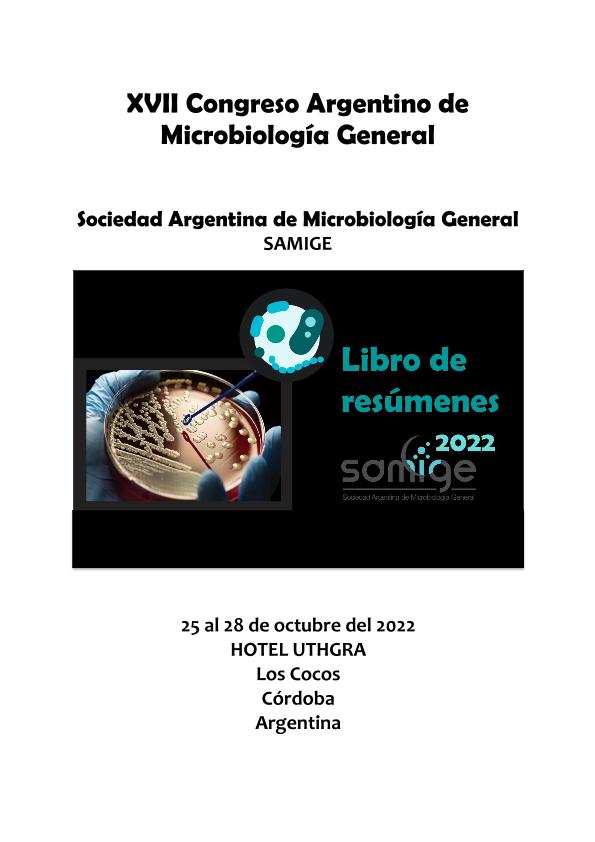Evento
Cloning and expression in E. coli of the linA gene from Streptomyces sp. M7, encoding a dechlorinase enzyme
Andrada Suarez, Eduardo Ezequiel ; Sandoval, Evangelina; Fernández Baldo, Martín Alejandro
; Sandoval, Evangelina; Fernández Baldo, Martín Alejandro ; Cuozzo, Sergio Antonio
; Cuozzo, Sergio Antonio
 ; Sandoval, Evangelina; Fernández Baldo, Martín Alejandro
; Sandoval, Evangelina; Fernández Baldo, Martín Alejandro ; Cuozzo, Sergio Antonio
; Cuozzo, Sergio Antonio
Tipo del evento:
Congreso
Nombre del evento:
XVII Congreso Argentino de Microbiología General
Fecha del evento:
25/10/2022
Institución Organizadora:
Sociedad Argentina de Microbiología General;
Título del Libro:
Libro de resúmenes del XVII Congreso Argentino de Microbiología General
Editorial:
Sociedad Argentina de Microbiología General
Idioma:
Inglés
Clasificación temática:
Resumen
Streptomyces sp. M7 is an actinobacterium isolated from contaminated sediments with heavy metals and pesticides in Northern Argentina and is able to grow in the presence of hexachlorocyclohexane isomers (γ-HCH, α-HCH, β-HCH) as carbon sources. This property is due to the presence of a high and low metabolic pathway for xenobiotics degradation, where the first enzyme corresponds to LinA, dehydrochlorinase/dehydrohalogenase. This is able to catalyze the breaking of the highly resistant C-Cl bonds of hexachlorocyclohexane, an essential step for its subsequent biodegradation into less toxic metabolic intermediates and/or final products such as carbon dioxide and water. In this work, the linA gene belonging to Streptomyces sp. M7 that codes for dehydrochlorinase (DHC) was synthesized (GenBank: MH703800). The sequence was adapted according to high-frequency-usage codons in E. coli. In the sequence redesign process, two restriction sites, NcoI and XhoI, were added, which are in the bacterial vector pET28a+ used for the expression of 6xHis-tagged N-terminal proteins with a thrombin site. Previously, the synthetic DNA sequence was constructed and cloned in a pTOP Blunt V2 plasmid that was later treated with both restriction enzymes, giving rise to an expected fragment of 475 bp. The released fragment was cloned into the pET28a+ vector and was transformed in competent E. coli BL21 (DE3) host cells with T7 phage promoter. In the same way, transformants were obtained with the expression vector without the cloning fragment and used as control. It should be noted that the plasmid sequence construction and analysis were performed using the Vector NTI software. Subsequently, for the differential expression assay optimization, different conditions were analyzed: 0.4 mM, 0.7 mM, and 1 mM of IPTG, temperatures of 30 and 37 °C and variable times. The most favorable setups were 1 mM of IPTG, 37 °C, and 2 hours of incubation. Subsequently, the cell-free extract was obtained by sonication and analyzed by SDS-PAGE. The stained gels showed a differential band of approximately 39,000 Daltons, confirming the expression of the LinA-6xHis fusion protein. This approach will allow the analysis of the LinA enzyme, as well as its subsequent application in bioremediation technologies.
Palabras clave:
DECHLORINASE
,
EXPRESSION
,
BIOREMEDIATION
,
LINDANE
Archivos asociados
Licencia
Identificadores
Colecciones
Eventos(INQUISAL)
Eventos de INST. DE QUIMICA DE SAN LUIS
Eventos de INST. DE QUIMICA DE SAN LUIS
Eventos(PROIMI)
Eventos de PLANTA PILOTO DE PROC.IND.MICROBIOLOGICOS (I)
Eventos de PLANTA PILOTO DE PROC.IND.MICROBIOLOGICOS (I)
Citación
Cloning and expression in E. coli of the linA gene from Streptomyces sp. M7, encoding a dechlorinase enzyme; XVII Congreso Argentino de Microbiología General; Los Cocos; Argentina; 2022; 73-74
Compartir



